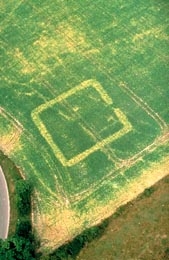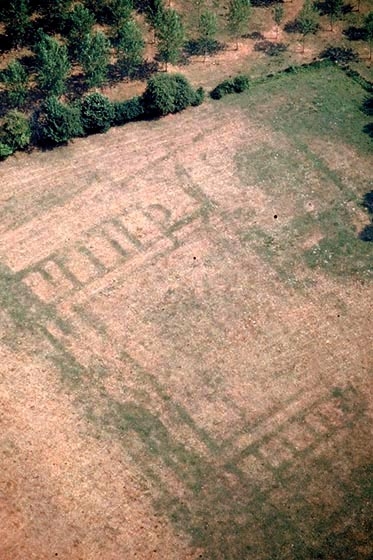- Home
- Clues on the ground
- Crop growth anomalies
- Contrasting colors
Color contrasts are easy to spot among ripening crops of grain, animal fodder or beets, as well as others crop types, such as leguminous plants.
Most French researchers have pointed out the usefulness of aerial observation over artificial grasslands about two weeks after the first harvest, when a second crop has begun to sprout.
Alluvial valleys, which have a layer of gravel at their base, are the best places to find contrasts in crop height and color. This is particularly true with grain crops, in which the variety of shades of green can be quite striking.
Contrasting colors, Saint-Remy-en-l'Eau (Oise) over ancient Gallic ditches.
Green pastures at Vélennes-Frémontiers (Somme) reveal Gallo-Roman foundations.
The different rates of yellowing as crops mature can sometimes be quite spectacular over filled-in pits. This is especially true of pea crops, but also of colza and grains.
In periods of prolonged drought, even grazing lands can reveal leveled-off foundations, like at Guizancourt (Somme). Curiously, however, in Velennes-Frémontiers (Somme) — on the same day and on the same type of marshy soil — the contrasts were reversed, and the grass was greener over the spot where Roman foundations could be seen. Thus, things are not as simple as they might appear. These phenomena have been noted for centuries by interested observers, well before the invention of aviation. Nonetheless, the current heavy use of fertilizers considerably reduces the differences in crop color and height, but does not totally remove them. All that is needed is a set of favorable (but unpredictable) circumstances for them to reappear.
Straight whitish lines correspond to the buried walls of a small Roman villa. The green patches are the result of the grassland being watered during the drought of June 1976. Guizancourt (Somme).



